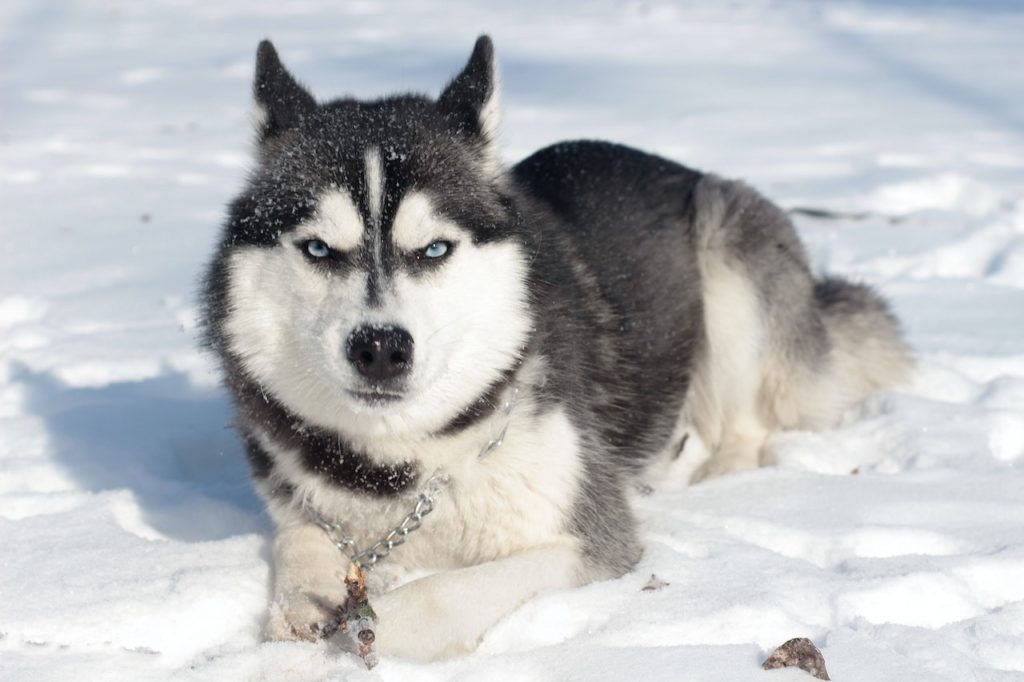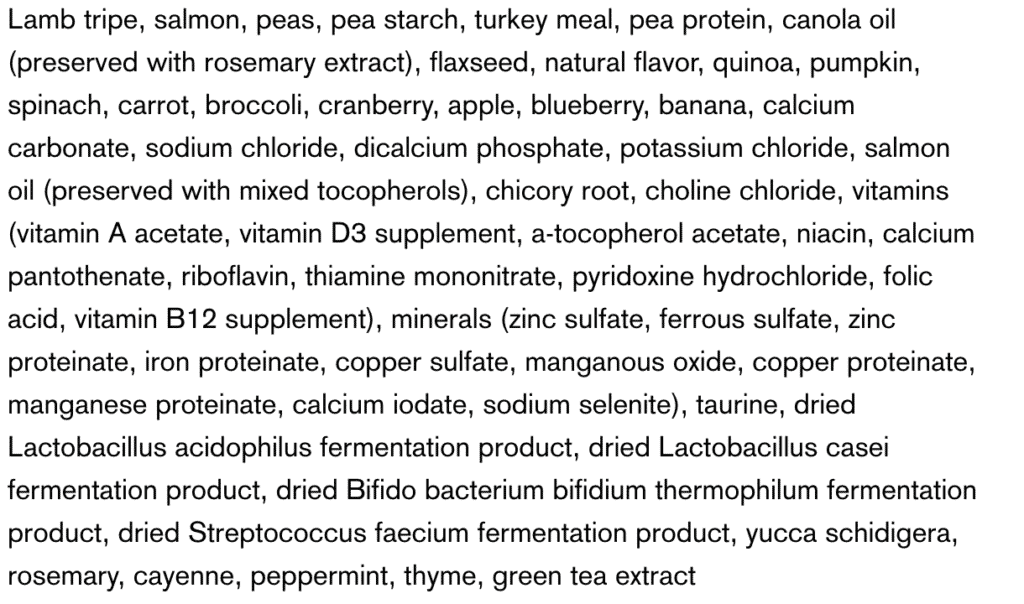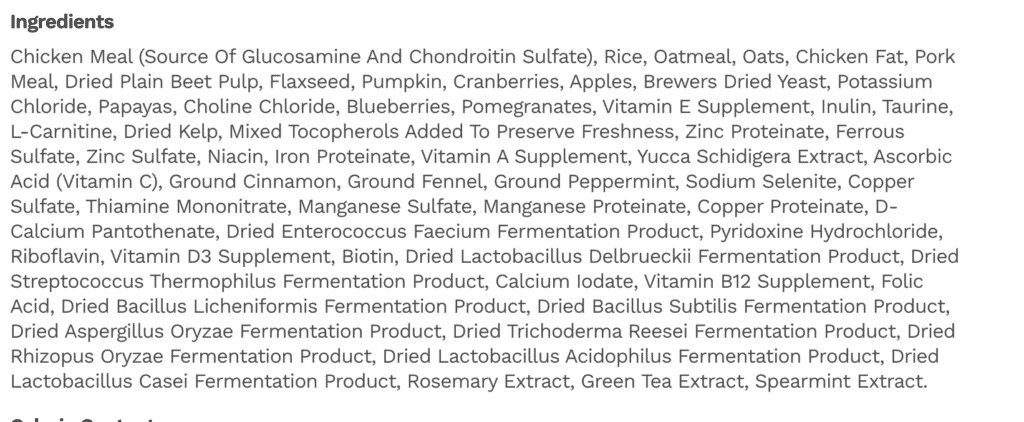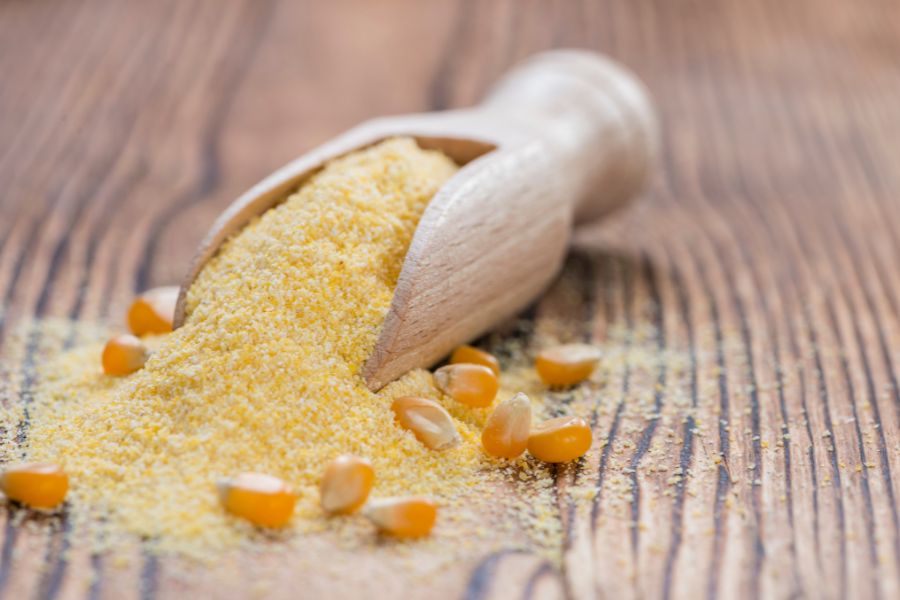Ingredient splitting in dog food is the dubious practice of rearranging labels to make the ingredients list look ‘healthy’. Like most dog owners, you want to ensure that your pup is eating the best nutrition possible.
How does ingredient splitting work? What does that mean, and should you be worried about your bag of pet food?
Ingredient Splitting in Dog Food: a uniquely boutique problem
The pet food industry is a growing multi-billion dollar franchise with new boutique diets popping up every single day. It is estimated that there are 300-400 new ones, each year!
Every new brand wants a piece of the pie and will say what they need to in order to gain your trust – and your money.
In this blog post, we’ll answer all of your questions about ingredient splitting in dog food and help you decide what nutrition is best for your giant breed dog!

What is Ingredient Splitting in Dog Kibble?
Ingredient splitting is when a pet food company takes a whole ingredient (for example, peas, oats, salt, or corn), and then lists it under multiple different names on the ingredients list.
This is a sneaky trick that makes the food look like it has more meat and high-quality, whole foods at the top of the ingredients list than it actually does.
Common pet food ingredients subjected to splitting
Below are some examples of common whole foods that may be split up on an ingredient list. Keep in mind that one single item, such as pea fiber, is ok. The problem is when a company uses multiple items from the whole ingredient, indicating that they are likely using splitting.
Peas may be listed as:
- Peas
- Whole Peas
- Pea Protein
- Pea Fiber
- Pea Flour
- Pea Starch
- Green Peas
- Yellow Peas
Corn may be listed as:
- Corn
- Corn Meal
- Corn Gluten Meal
- Corn Flour
- Corn Starch
- Whole Grain Ground Corn
Potatoes may be listed as:
- Potatoes
- Potato flour
- Potato protein
- Dried Potatoes
- Whole Potatoes
- Potato starch
Oats may be listed as:
- Oats
- Whole Oats
- Oatmeal
- Oat Groats
- Oat Flour
- Oat Fiber
Additionally, food companies may choose to use multiple versions of the same food so that each one makes up a smaller weight. Examples include:
- Yellow peas, green peas, split peas
- Red lentils, yellow lentils, green lentils
By turning a single, whole item into separate ingredients on paper, dog food manufacturers can artificially inflate the perception of real meat content in the food, even if it’s not the most abundant ingredient.
How Pet Food Manufacturers Fool Dog Owners
The FDA regulates what goes on pet food labels in the United States, but there are still ways for companies to manipulate their ingredient lists.
For example, a company could put ‘chicken’ as the first ingredient on their food list. But because “fresh” chicken contains roughly 70% water, it could actually be of lower content than other ingredients (once the kibble is extruded).
It would still be listed first, however, because labeling requirements state that ingredients must be listed based on their pre-cooked (water included) weight.
Ingredient splitting further ensures that chicken stays at the top, even though most of its weight and bulk of it is lost during the cooking process. Read our section on by-products below to learn more!
Water content is not required to be listed on pet food brand labels so that companies can get away with this.

Marketing in commercial dog food
The dog food industry is a multi-billion dollar market with thousands of companies fighting for market share.
To differentiate their products, pet food companies will use marketing tricks such as:
-Attractive packaging, often with photos of vegetables, fruits, and skinless, boneless fresh, or roasted meats
-Making bold claims of robust health and longevity
-“Humanizing” their ingredients (“Farm Fresh Deboned Chicken”)
-Placing large amounts of different fruits and vegetables in the ingredients list (which appeal to the consumer but do little for nutritional content)
-Using celebrity and influencer endorsements, including viral pet owners on social media, “veterinarians”, and “nutrition experts”
-Relying on unregulated marketing terms such as “holistic”, “human-grade” and “super-premium”
These tricks are NOT actually an indication of a product being “higher quality”, though people perceive it that way.

How Ingredient Splitting Math Works
Let’s do the math!
If I have 10oz of “widgets” and 8oz of Fresh Roast Beast in my kibble, by law I have to list “widgets” first (because they weigh the most, before cooking).
My current formula looks like this:
Widgets, roast beast, rice, lentils, roast beast fat, salt, vitamins & minerals.
BUT I want people to believe that roast beast is the primary ingredient, so I break “widgets” up to keep it on the top of the list (and add some yummy-sounding ingredients in minute amounts to appeal to the customer)
10oz of “widgets” becomes (for example):
- 5oz of widget fiber
- 3oz of widget starch
- 2oz of widget protein
Each one has smaller pre-cooking weights that add up to the original 10oz, but because they now individually weigh less than the roast beast, they can move down the ingredients list.
Widgets as a whole, however, still outnumber the meat in the final extruded product…especially once all of the water is removed from the roast beast!
My new more ‘appetizing’ looking formula might look like this, even though the ingredients are essentially the same:
Fresh deboned roast beast, rice, widget fiber, roast beast fat, green lentils, widget starch, widgets, pumpkin, widget protein, red lentils, squash, green lentils, choline chloride, apples, fish oil, potassium chloride, vitamins & minerals.
Companies that practice ingredient splitting are not being truthful to their consumers. Savvy consumers should ask questions and move well beyond the “holistic” and “super-premium” marketing labels.
Ingredient splitting is one of the pet food industry’s biggest, most dirty marketing tricks.

Real-Life Example #1 – Ingredient Splitting
Here is an example of a boutique dog food that uses ingredient splitting to make its formula look meat-focused. This brand uses ‘premium grade’, ‘organic’, and ‘biologically appropriate’ marketing terms. They also promote that their brand has ‘meat in the first ingredient’.
Peas, pea starch, and pea protein all add up to…PEAS. We can reasonably assume that peas are ingredient #2, or even #1 by weight because both lamb tripe and fresh salmon are heavy in water (before cooking).
They have also split salt into 3 different ingredients so that it’s lower on the ingredients list than the pumpkin, spinach, broccoli, and other ‘nutritious’ foods that were included in minuscule amounts for marketing purposes.
Additionally, the heavy use of peas in dog food is the KEY suspect in studies showing that untested, poorly formulated boutique foods are contributing to an alarming increase of N-DCM and sudden death in dogs.
The calcium/phosphorus ratio on this food is alarming and can cause damage to large and giant breed dogs (1.7% calcium to .08% phosphorus).
This healthy-looking ‘holistic’ brand contains very little meat meal (meat+bone+organs) and no animal fats; two things that are, in fact, biologically appropriate.
When you learn to look past the marketing and read labels correctly, the results are shocking:


Real-Life Example #2: Ingredient Splitting
See below and note the use of multiple versions of the same ingredients (red and green lentils, green and yellow peas), which is a form of ingredient splitting.
Also take note of the addition of kelp, collard greens, apples, pears, and pumpkin. These items are listed after salt on the ingredients list, indicating that they make up only a few grams per pound (or less) in the food.
The marketing on the bag makes you think that this is a healthy, well-balanced meat feast for your dog. What you are really getting may be nothing more than a bag of meat-flavored lentils, beans, and vegetables.
Lastly, in their effort to avoid the word ‘by-product meal’ (which has unfortunately negative connotations despite being incredibly nutritious), they have utilized multiple forms of kidney, liver, and tripe instead.
All of those things are in fact, by-products.


Real-Life Example #3: Ingredient Splitting
The next example is from Earthborn Holistics Large/Giant Breed formula. The blue bag with the Great Dane on it!
This popular food in the Great Dane community is full of ingredient splitting. As you can see, this practice is not uncommon and has been made to mislead you!
By now, you may start to see the splitting happening. If not, here is the run-down.
Chicken meal is fantastic. It’s followed by rice, oatmeal and oats.
But wait, aren’t oatmeal and oats the same thing!?
They are. But by splitting them, this company effectively moved chicken fat down into the 5th spot on the ingredients list.
Some studies have shown that chicken fat in the first 4 ingredients increases the risk of deadly bloat in dogs.
EDITORS NOTE:
The only acceptable forms of chicken fat high on the list in large/giant breed foods will be from companies who use a well-sourced by-product meal in the first ingredient. This is a biologically correct inclusion with meat, organs, tissue, and bone that even after cooking will still comprise the bulk of the food and nutrition.
Royal Canin Giant Breed is a great example of this and is thus exempt from the “avoid chicken fat in the first 4 ingredients” rule.
Earthborn Holistic below has also split the salt up into multiple ingredients; many companies do this and it’s not necessarily bad (there may be a nutritional reason for the two different forms).
However, it’s important to note that this keeps marketing inclusions such as apples and cranberries higher up on the list – even though they likely make up less of the actual formula than salt.

Pet Food Industry Myths Busted
Several myths in the pet nutrition industry have been perpetrated by people with very little background in peer-reviewed, scientific canine nutrition.
“Grain-free is better for dogs”
“Kibble is full of by-products and slaughterhouse waste”
We will cover these myths in depth below.
Are by-products in dog kibbles healthy?
By-products (often seen on the label as ‘Chicken By-Product’ or ‘Meat By-Product Meal) are catch-all terms for anything that is left over after other parts of the animal have been used.
This can include bone, beaks, feet, tendons, tissue, and internal organs; all things that some humans do not care to eat and may even find repulsive.
Read more about by-products HERE!
A meat by-product meal is the rendered version of this; all of the water and fat is removed and what is left is a nutrient-dense, pathogen-free product that, when added to pet food, can make up the bulk of the important nutrition.
Beef meal, chicken meal, and fish meal are similar products (rendered meats) that you may have seen on a food label. By-product meal is similar, nutrient-wise, to a whole-prey model raw food diet and is much more protein-rich and nutritious than ‘fresh deboned meat’.
Have you ever given a whole chicken to a dog? If you aren’t aware, dogs will eat the WHOLE THING. Eyes, feet, organs, bone, meat, blood, and yes, the beak.
https://vetnutrition.tufts.edu/2016/05/dont-be-bothered-by-by-products
These items are necessary for good health and nutrition in our canine companions.
So don’t let the word “by-product” fool you. If you feed your dog pig ears, bully sticks, freeze-dried liver treats, or chicken feet, you are feeding your dog by-products!
As a rendered item, by-product meals already have the moisture removed before extruding. So unlike fresh muscle meat, if they are heavy before cooking, they still will be after they become kibble, too.

Real-life example
Below is a traditionally “scary-looking” ingredients list with a by-product meal as the first ingredient.
Marketing has taught us to view this label as ‘garbage’ or ‘junk’.
Influencers ‘flip the bag’ and teach us to be disgusted and alarmed.
BUT:
Each ingredient is different, from a different source, and has a different purpose. Because a by-product meal is a nutrient-dense dry product before cooking, it remains at the top of the list without any ingredient splitting needed to keep it there.
It may be tempting to choose the Acana formula (from the real-life example above) that contains healthy-sounding lentils, kelp, pumpkin, and multiple meat sources.
However, don’t be fooled! This Royal Canin diet below very likely contains more actual nutrition from meat than the Acana ‘Red Meat Recipe’ from above.
The more you know!


Does dog kibble contain slaughterhouse waste?
This is a myth that has been perpetuated by people with very low actual credibility.
The fact of the matter is that there are laws in place (regulated by the FDA) regarding the sourcing, control, and quality of ingredients that are processed into dog and cat food.
The FDA has a zero-tolerance policy for any adulterated products (including drugs, cosmetics, and feed) that enter the marketplace. It’s time to lay this myth to rest.
Is grain-free healthier for my pet?
Grain-free diets have become super popular because of, you guessed it, marketing.
People see the words “grain-free” and think that it means healthier when in reality, it just means… grain-free.
There is no nutritional evidence to support the claim that grain-free diets are any healthier for dogs than diets that contain grains.
In fact, the FDA has identified a link between untested boutique dog foods (often “grain-free”) and an alarming increase in life-threatening heart problems in dogs.

How to Choose an Ethical Pet Food Company
When looking for an ethical pet kibble company, look for these key things:
-A full-time board-certified Veterinary Nutritionist (DACVN or ACVN) on staff (not “consults with” or “works with”, but employs)
-The use of AAFCO food trials to substantiate their formulation in real life, not just on paper
-Participation in peer-reviewed companion animal nutrition research (actually cares about companion animal health, doesn’t just claim to)
-A commitment to transparency and education, not excuses and marketing buzzwords
Take the Dog Food Advisor with a grain of salt. It is a clickbait affiliate income website, run by a human dentist, that uses a made-up rating system.
Here are some helpful links:
Every Ingredient Has a Purpose (By Purina)
Advancing Science for Pet Health (Purina Institute)

HOW DOES YOUR DOG FOOD STACK UP?
THE PET NUTRITION ALLIANCE
Search for your food brand. Who formulated it? Does it meet standards? Are they transparent about their dedication to science and nutrition?
What is the WSAVA?
The WSAVA is the World Small Animal Veterinary Association.
They are an organization of over 200,000 veterinarians in over 100 countries who are dedicated to improving the health and welfare of companion animals worldwide.
The WSAVA has a Nutrition Toolkit that provides comprehensive resources for pet owners and veterinarians on how to choose a pet food and what to look for on the label.
The WSAVA does NOT endorse or approve any pet brands.
https://vetnutrition.tufts.edu/2016/06/why-you-shouldnt-judge-a-pet-food-by-its-ingredient-list

Best Foods for Giant Breed Dogs
The list of foods below comes from companies that put their money into scientific research, feeding trials, nutrition sciences, veterinary support, and hiring highly qualified board-certified veterinary nutritionists to formulate the kibble.
All of these are formulated correctly for giant breed dogs.
Giant breed puppy food
- Purina Pro Plan Large Breed Puppy – any flavor!
- Purina Pro Plan Sensitive Skin & Stomach Large Breed puppy – TOP PICK, salmon-based
- Eukanuba Large Breed Puppy (Great for active and sporting dogs)
- Purina One Large Breed Puppy (Excellent budget option)
- Hill’s Science Diet Puppy Large Breed
- Royal Canin Giant Puppy Dry Dog food (to age 12 months) – TOP PICK, PREMIUM OPTION
- Royal Canin Giant Junior Dry Dog food (8-24 months)
- Purina Large Breed Puppy Chow
Check out THE GIANT DOG FOOD PROJECT to compare brands and values.
Giant breed adult food
- Purina Pro Plan Sensitive Skin and Stomach Large Breed (Salmon based, chicken free)
- Purina Pro Plan Large Breed Shredded Chicken & Rice (Large Pieces & Chicken Shreds!)
- Purina Pro Plan Large Breed Weight Management (Get the weight off)
- Purina Pro Plan Large Breed Bright Mind Age 7+ (for Senior Great Danes)
- Purina Pro Plan Giant Breed (Hard to find, might be discontinued)
- Royal Canin Giant Breed (Amazing for dogs with chronic loose stools, TOP TIER)
- Eukanuba Large Breed (Great for active and sport dogs)
- Purina One Smart Blend Large Breed (Fantastic budget-friendly option)
- Hill’s Science Diet Large Breed Beef & Rice
- Purina Pro Plan 30/20 Sport Beef & Bison

Want more? Here are some great, comprehensive articles on food and nutrition, from a veterinary professional (not influencers or boutique food companies that stand to make money on your purchase):
http://vetharmony.org/blog/2016/12/16/what-food-should-i-feed-my-pet?fbclid=IwAR3zf4n4sphyfKGo9KEejAmCvXG6sWlCyug4w2dzoIDgW2svgicobZ2cggU




